Tobacco use among adolescents in Scotland: profile and trends
The report presents analysis of trends and associations for smoking amongst 13 and 15 year old pupils between 1990 and 2013. Smoking is at its lowest level since the survey began.
This document is part of a collection
4. FAMILY, FRIENDS, SOCIETY AND HEALTH
SALSUS asks a number of questions about the circumstances and lifestyles of the respondents. Responses to these questions have been used to explore whether certain characteristics are more or less associated with smoking behaviours. Note that this section deals with 15 year olds, except where noted.
FAMILY STRUCTURE
There were no major changes in the proportion of respondents living in any family structure between 2006 and 2013, apart from an increase in the percentage living with single parents (Figure 4.1).[23]
Figure 4.1: Family structure: change over time
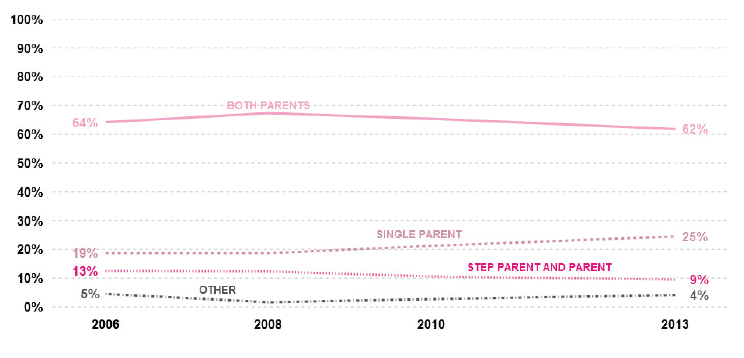
Base: all 15 year olds, 2006 -2013
Regular smokers are more likely to be living in a family structure other than with both parents than occasional or non-smokers (Figure 4.2).
Figure 4.2 - Different family structure within smoking status groups
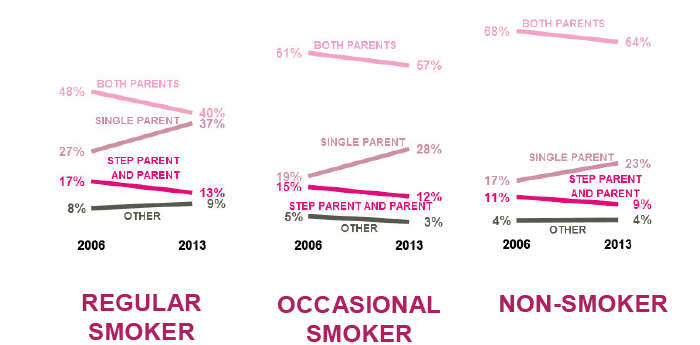
Base: all 15 year olds in each smoking group (2006, 2013) - regular (1667, 1306); occasional (647, 694); non-smoker (8758, 13658)
Pupils who live with both of their parents are less likely to be regular smokers than those living in single parent or step parent families. Pupils in 'other' family situations - those living with siblings, grandparents, foster parents or in care homes - are consistently most likely to be regular smokers (Figure 4.3).
Figure 4.3 - Family structure: smoking status in each group
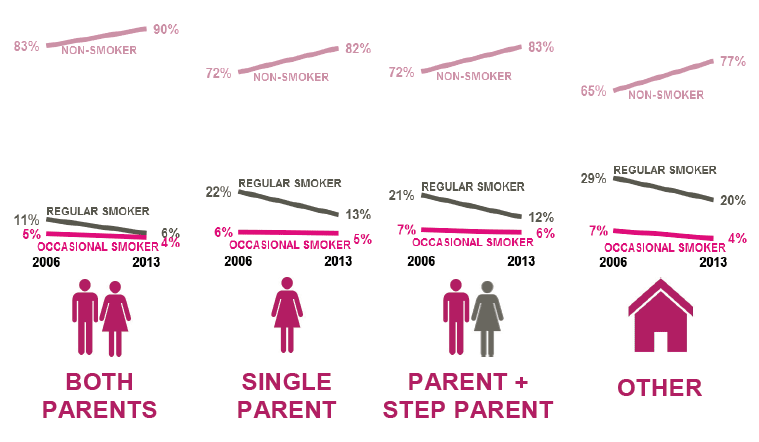
Base: 15 year olds, by different family structures and smoking status, 2006-2013
PARENTAL KNOWLEDGE OF CHILD'S ACTIVITIES
Pupils have been asked how much they think their mother/father/carer knows about who their friends are, how they spend their money, where they are after school, where they go at night, and what they do with their free time, in each survey between 2002 and 2013. The responses were combined into a total score and these were banded as below, at or above median knowledge.
Respondents whose mother or father is above or at median knowledge of their activities are much less likely to be regular smokers than those who believe their parents are below median. For girls, in general, a lack of parental knowledge was associated with a much greater likelihood of being a regular smoker and parents knowing about their activities greatly reduced that likelihood (Figure 4.4).
Figure 4.4 - Parental knowledge: change in regular smoking status in boys and girls, 2002 and 2013[24]
| MATERNAL KNOWLEDGE | PATERNAL KNOWLEDGE | GIRLS | BOYS | ||
|---|---|---|---|---|---|
| 2002 | 2013 | 2002 | 2013 | ||
| BELOW MEDIAN | BELOW MEDIAN | 37% | 17% | 22% | 11% |
| AT MEDIAN | 29% | 7% | 19% | 5% | |
| ABOVE MEDIAN | 30% | 9% | 18% | 14% | |
| AT MEDIAN | BELOW MEDIAN | 21% | 6% | 15% | 9% |
| AT MEDIAN | 13% | 3% | 9% | 2% | |
| ABOVE MEDIAN | 21% | 4% | 15% | 4% | |
| ABOVE MEDIAN | BELOW MEDIAN | 22% | 6% | 16% | 7% |
| AT MEDIAN | 22% | 2% | 8% | 1% | |
| ABOVE MEDIAN | 13% | 2% | 8% | 4% | |
FRIENDS' AGES AND TIME SPENT WITH FRIENDS
The majority of pupils report that their friends are the same age as them and this has increased slightly between 2006 and 2013. Only a minority of respondents said their friends were mostly older or mostly younger than them and this has not changed over time (Figure 4.5).
Figure 4.5 - Ages of friends changes over time
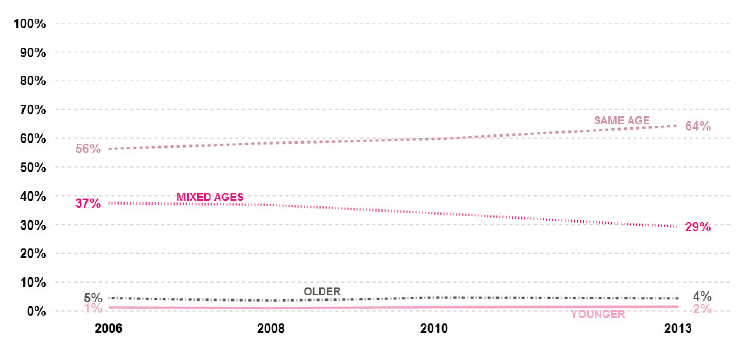
Base: 15 year olds who answered this question
Smokers are more likely to say their friends are mixed ages or older than them than non-smokers are (Figure 4.6).
Figure 4.6- Smoking status - friend ages by smoking status
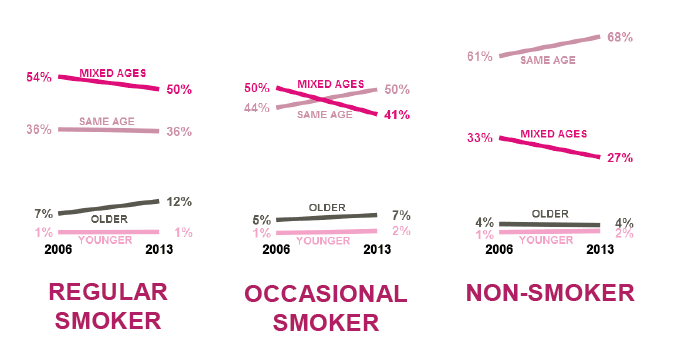
Base: 15 year olds who answered this question
Similarly, respondents whose friends are older than them or of mixed ages are more likely to be regular smokers (Figure 4.7).
Figure 4.7 - Age of friends - smoking status
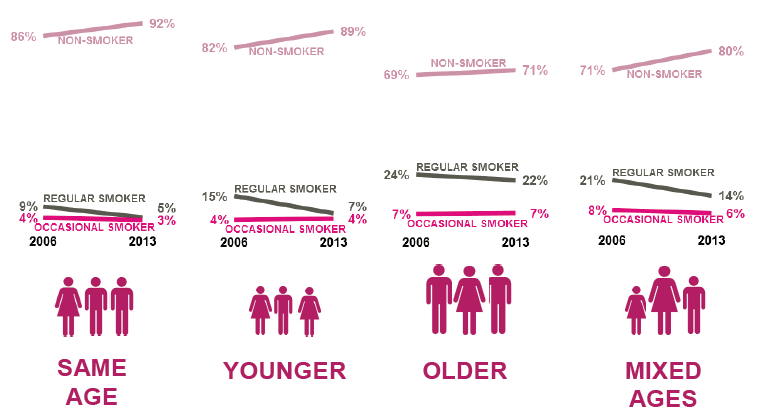
Base: all 15 year olds, 2006, 2013
The number of evenings spent out with friends has a constant strong association with regular smoking - the greater the number of nights spent out with friends, the increased likelihood that the 15 year old is regularly smoking (Figure 4.8).
Figure 4.8 - Evenings spent out with friends - smoking status
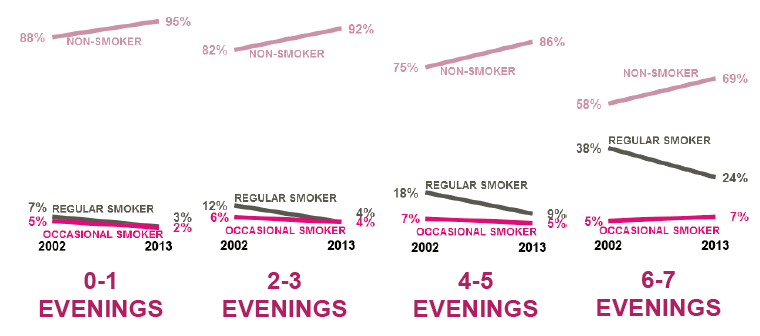
Base: all 15 year olds, 2002 - 2013
LEISURE ACTIVITIES
SALSUS asks what pupils do in their free time and how often they engage in a range of specific leisure activities, as well as whether they have attended any groups, clubs or organisations in the past 12 months. The activities cover a broad range and include a mix of supervised and less structured activities. Attendance at various types of club has not changed much over time, though there has been a drop in youth group attendance and an increase in 15 year old pupils going to a sports club, gym, exercise or dance group (Figure 4.9). [25]
Figure 4.9 - Leisure activities: changes in percentage of 15 year olds doing activities at least weekly between 2002 and 2013
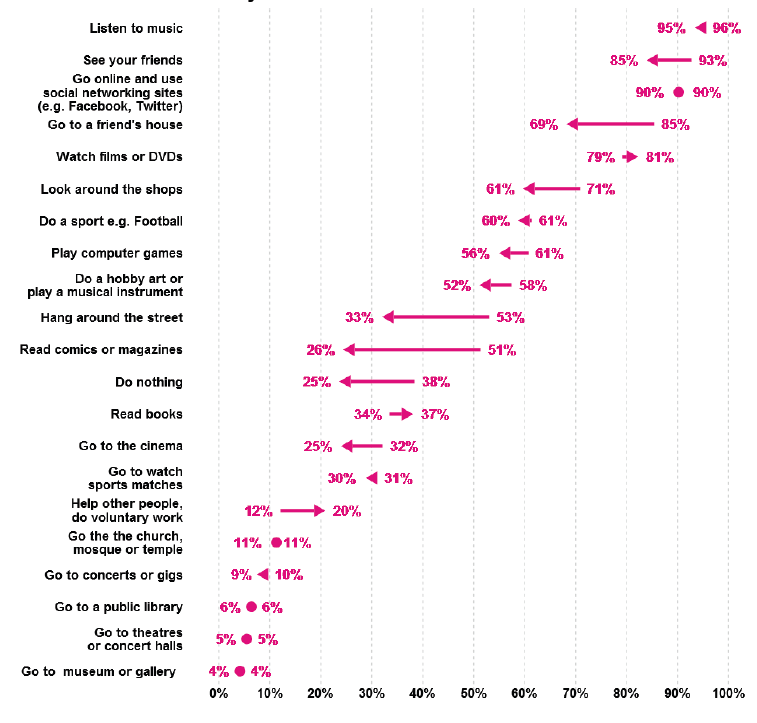
Base: Base: varies from question to question (full bases in Appendix A, Table A.8; full data in Appendix B, Table B.7)
Pupils who do not take part in any club or group are more likely to be regular smokers than those who do - this is consistent over time. Taking part in a sports club, gym, exercise or dance group has the strongest association with whether the child is a regular smoker or not, followed by participation in drama, arts or music groups. Youth group or computer club participation appears to have no association with smoking status (Figure 4.10).
Figure 4.10 - Club/group attendance by regular smoking status
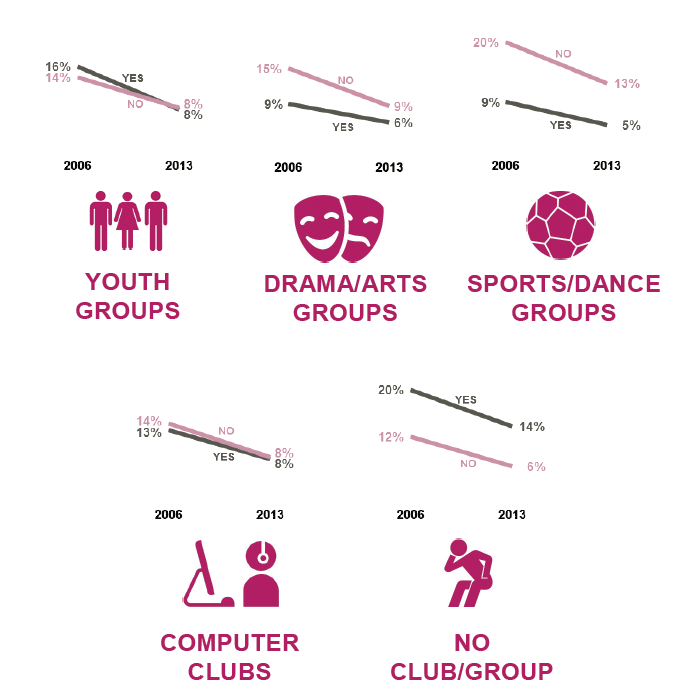
Base: all 15 year olds (full bases in Appendix A, Table A.6)
All of the activities asked about in SALSUS were used in a linear regression model to explore whether carrying any of them out at least weekly was significantly associated with regular smoking. Playing sport was found to have the greatest "protective" association and hanging around on the street had the greatest negative association, closely followed by going to concerts/gigs. Most activities did not significantly impact on the likelihood of being a regular smoker (Figure 4.11). Note that these interactions may be relatively complex and do not necessarily imply that these factors directly cause smoking/non-smoking but that they explain a significant amount of variation in the model. Details of the logistic regression can be found in Appendix C.
Figure 4.11 - Weekly leisure activity: association with being a non-smoker for all 15 year olds[26]
![Figure 4.11 – Weekly leisure activity: association with being a non-smoker for all 15 year olds[26] Figure 4.11 – Weekly leisure activity: association with being a non-smoker for all 15 year olds[26]](/binaries/content/gallery/publications/statistics-publication/2016/02/tobacco-use-adolescents-scotland-profile-trends/00493474.gif)
Base: see Appendix C for information on the logistic regression
SCHOOL LIFE
The proportion of 15 year olds who say they like school has stayed fairly constant between 2002 and 2013, with 62-66% saying they like school a bit or a lot. Those who said they did not like school at all were more likely to be regular smokers than those who did like school, though the percentage who smoke has fallen over time for all groups (Figure 4.12).
Figure 4.12 - Liking school: pupils in each smoking category
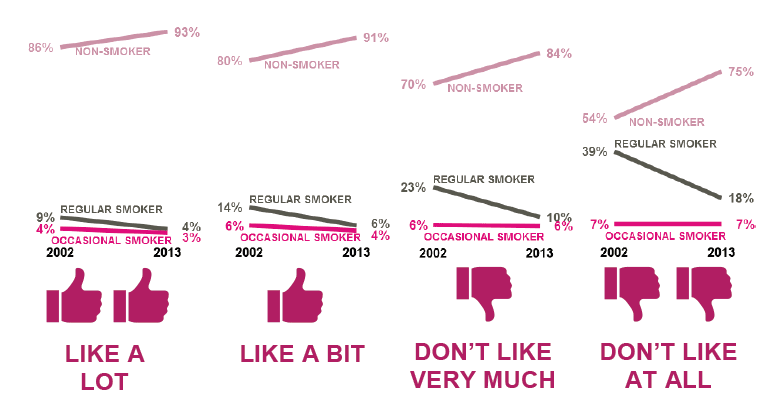
Base: all 15 year olds, 2002-2013
There has been a shift over time in how stressed pupils feel by school, with more pupils feeling stressed by school work a lot of the time rather than just sometimes in 2013 than in any other year. Stress has been increasing for all groups, though non-smokers are the least stressed by school work (Figure 4.13). Regular smokers are slightly more likely to be never stressed by school work, but the percentage who are has not changed over time for them or any other group over time, staying at around 10%.
Figure 4.13 - Stressed a lot of the time by school work - by smoking status
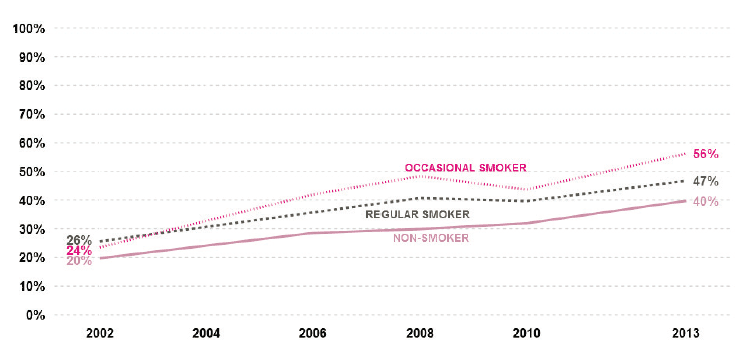
Base: all 15 year olds, 2002-2013
There was no clear association in the data over time between feeling stressed from school work and smoking status.
The proportion of respondents who have been excluded from school varies between 9% to 11% each year investigated by SALSUS, though regular smokers are consistently more likely to have been excluded. Pupils who have been excluded are more likely to be regular smokers, though smoking frequency is decreasing in both groups (Figure 4.14).
Figure 4.14 - Excluded: change over time (left) and smoking prevalence if excluded or not (right)
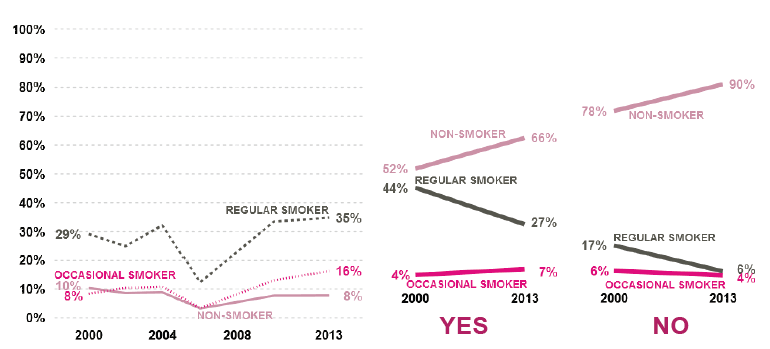
Base: all 15 year olds (full bases Appendix A, Table A.7)
The number of pupils who reported truanting in the last school year has decreased over time (Figure 4.15). Regular smokers are much more likely to have truanted and to have truanted more often than others (Figure 4.16).
Figure 4.15 - Truanting: change over time
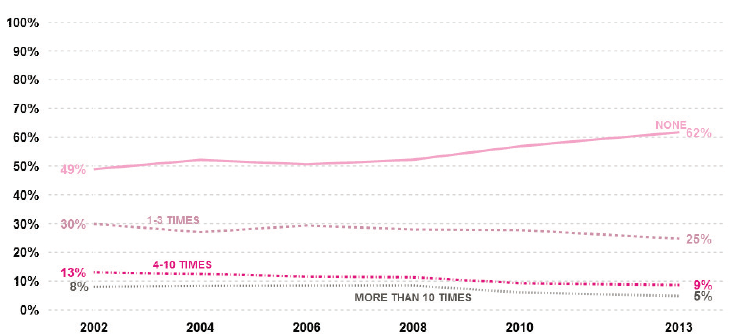
Base: all 15 year olds, 2002-2013
Figure 4.16 - Smoking status: number of times truanted
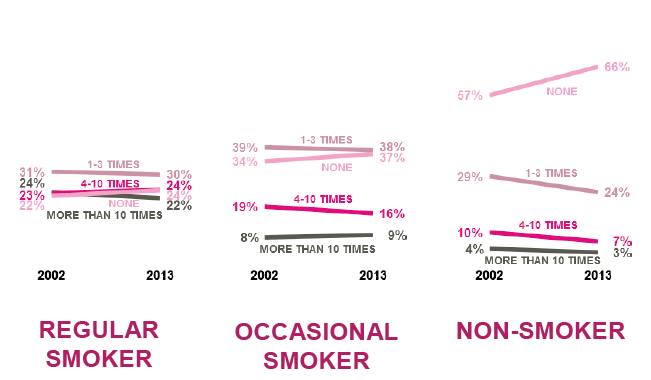
Base: all 15 year olds, 2002- 2013
POST-SCHOOL EXPECTATIONS AND ASPIRATIONS
When 15 year olds are asked what they think they will most likely do after school, the most common answer is go to university which has increased over time from 45% of all 15 year olds in 2002 to 53%. The increase in those wanting to go to university appears to be driven by those in the lowest SIMD quartile, which increased by 14% between 2008 and 2013 (Figure 4.17).2 Those expecting to go on to FE has changed from 28% to 21% over the same period, to be working from 9% to 8%, to be in an apprenticeship from 7% to 6%, and some other destination or activity has moved from 11% to 12%.
Figure 4.17 - Expecting to go to university by SIMD quartiles
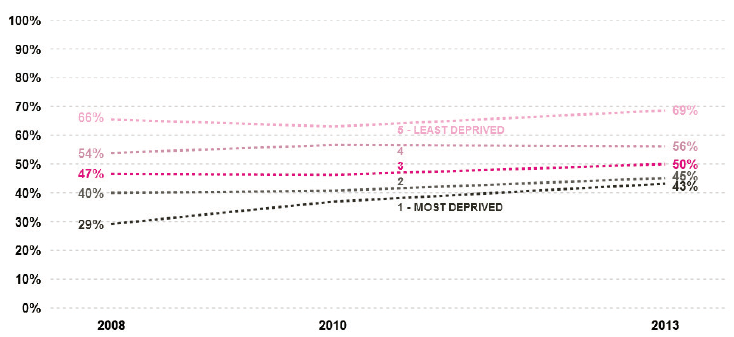
Base: all 15 year olds, 2008-2013
Pupils aspirations are associated with smoking status and this has persisted over time. For example, regular smokers are much less likely to say they will go to university than non-smokers (Figure 4.18).
Figure 4.18 - Post-school expectations within smoking status groups
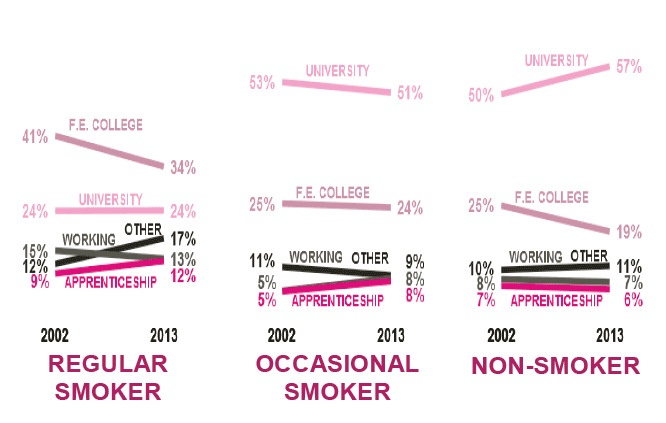
Base: all 15 year olds, 2002, 2013
GEOGRAPHIC VARIATION
Across the 14 Scottish Health Boards, the 15 year old regular smoking rate ranges from 6% to 12%. Fife, Dumfries and Galloway and Highland health boards have the highest smoking rates, while Eilean Siar, Tayside and Lothian boards have the lowest. The greatest declines between 2002 and 2013 were in Grampian, Tayside and Lothian, while Greater Glasgow and Clyde and the Scottish Borders have declined the least (Figure 4.19). Some of the greatest declines were in board areas which started with relatively high rates of smoking and lowest declines in areas that had low prevalence to begin with.
Regular smoking by 15 year olds ranges from 5% to 13% across Scottish local authorities. It is most common in Falkirk, Argyll and Bute, and Fife, and least common in Eilean Siar, Dundee City and Aberdeen City. Local authorities which have seen the largest decline in 15 year olds smoking between 2002 and 2013 are Aberdeenshire, Midlothian and Dundee City and those with the lowest decline are East Ayrshire, Scottish Borders and Glasgow City (Figure 4.20). As with health boards, some of the greatest declines were in areas which started with relatively high rates of smoking and vice versa.
Figure 4.19 - Local health board: change between 2002 and 2013 in regular smoking
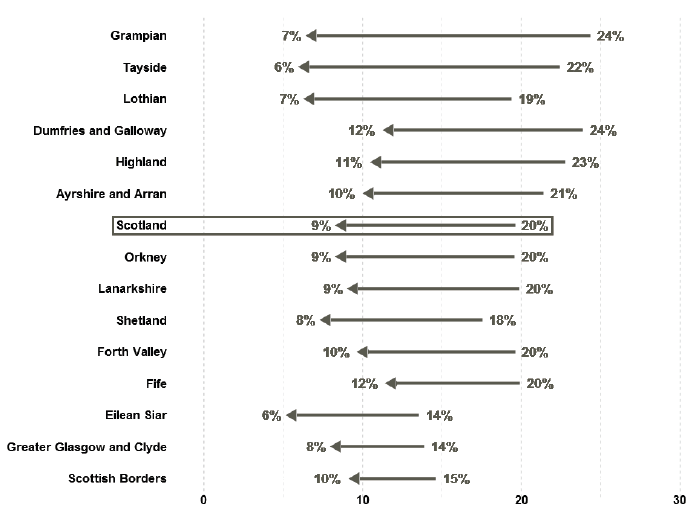
Base: all 15 year olds in each local authority and health board area (full bases in Appendix A, Tables A.9 and A.10)
Figure 4.20 - Local authority: change 2002-2013 in regular smoking[27]
![Figure 4.20 – Local authority: change 2002-2013 in regular smoking[27] Figure 4.20 – Local authority: change 2002-2013 in regular smoking[27]](/binaries/content/gallery/publications/statistics-publication/2016/02/tobacco-use-adolescents-scotland-profile-trends/00493483.gif)
Currently, there is no evidence of a rural/urban difference in regular smoking in SALSUS. Rates of smoking in small towns, urban areas and rural areas have converged since 2008 (Figure 4.21).
Figure 4.21 - Rural/urban classification: change in regular smoking over time[28]
![Figure 4.21 – Rural/urban classification: change in regular smoking over time[28] Figure 4.21 – Rural/urban classification: change in regular smoking over time[28]](/binaries/content/gallery/publications/statistics-publication/2016/02/tobacco-use-adolescents-scotland-profile-trends/00493484.gif)
Base: all 15 year olds (2008-2013) - urban areas (3023, 11501, 10606); small towns (678, 2265, 2343); rural areas (941, 3945, 3134)
HEALTH AND MENTAL HEALTH
Adolescents who smoke report poorer physical and mental health than those who do not. For example, in 2013, 88% of non-smokers rated their health as 'good' or 'very good' compared just to 60% of regular smokers. Nearly a quarter of regular smokers reported having a physical or mental condition lasting or expecting to last 12 months compared with 13% of non-smokers.[29]
Pupils who report better health in general than their peers are less likely to be regular smokers than those who report their health is poor. This picture has been consistent across the time series. Figure 4.22 shows that 34% of young people reporting poor health in 2013 were regular smokers compared to just 9% of all 15 year olds being regular smokers.
Figure 4.22 - Self-reported health status: regular smoking over time
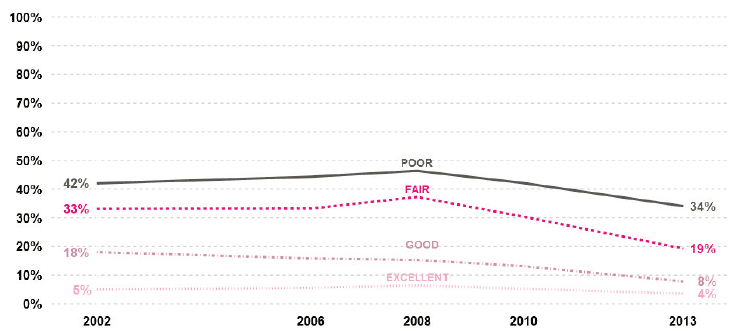
Base: all 15 year olds, 2002-2013
Respondents with a long standing physical or mental health condition are slightly more likely to be regular smokers, with likelihood increasing in line with the degree to which the condition impacts on daily life (Figures 4.23). Whether the illness or condition impacts on the respondent's day to day life was only asked in 2013 when 13% of those with such a condition reported that it did.[30] Figure 4.23 shows that smokers are more likely to report that their condition impacts more on their daily life than non-smokers with a chronic condition.
Figure 4.23 - Longstanding condition: impact on day to day life (left) and regular smokers in each category of impact (right)
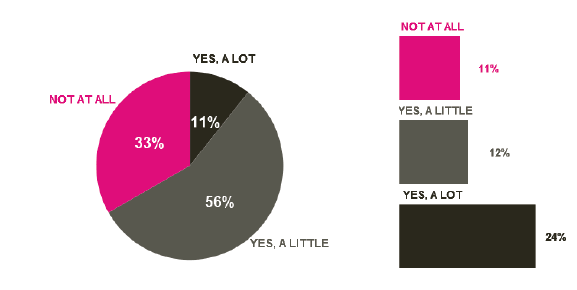
Base: Left - all 15 year olds with a longstanding illness - 2013 (2344)
Right - all 15 year olds with a longstanding (2013), by impact, and who are regular smokers - not at all (258); yes, a little (1307); yes, a lot (756) -
Since 2006, SALSUS has included the Strengths and Difficulties Questionnaire (SDQ) which is used to gather data on the pupil's mental wellbeing.[31] This is a self-report behavioural screening questionnaire which is used to identify abnormal behaviour in children in research and clinical environments. Respondents who complete the set of questions are scored on emotional symptoms, conduct problems, hyperactivity/inattention, peer relationship problems and pro-social behaviour, with each individual scale and their behaviour overall scored as normal, borderline or abnormal. A full discussion of trends in overall in SDQ scores and for SDQ constituents is included in the report Mental health and wellbeing among adolescents in Scotland: profile and trends.[32] Since 2006, the proportion of pupils with a borderline or abnormal SDQ score has risen slightly. This has been driven by a large increase in 15 year olds girls with these scores - the percentage of 15 year old boys has always been lower than girls and only rose slightly between 2006 and 2013.
Pupils whose responses generated an abnormal or borderline SDQ score were far more likely to be regular smokers so for example, Figure 4.24 shows that in 2013 19% of those with an abnormal SDQ score were regular smokers while just 9% of 15 year olds who smoke regularly and 14% of all 15 year olds have an abnormal SDQ score. When respondents were classified by individual SDQ scales, those with abnormal or borderline conduct scores, followed by those with hyperactivity or inattention problems, were found to be more likely to smoke regularly. Differences in scores for emotional symptoms, peer problems and pro-social behaviours were all less notable, though scoring abnormally in these categories still has an association.
The coincidence of an abnormal SDQ score and smoking status is more apparent for girls than for boys: girls with abnormal SDQ scores are more likely to regularly smoke and by 2013, normal and borderline scoring girls are slightly less likely to smoke than normal boys (Figure 4.25).
Figure 4.24 - SDQ score: regular smoking by banded scores
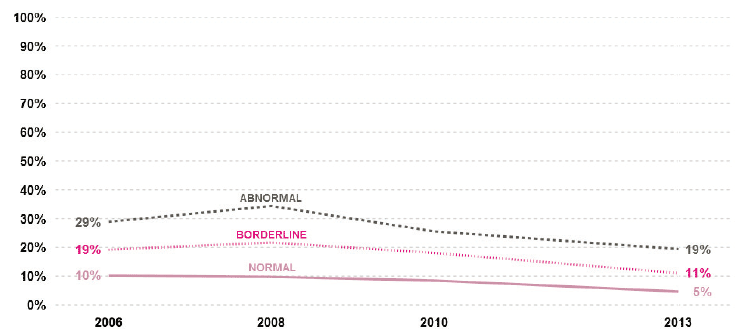
Base: all 15 year olds (2006-2013) - normal (7278, 3263, 12333, 10349); borderline (1604, 687, 2508, 2516); abnormal (1004, 453, 1791, 2249)
Figure 4.25 - Regular smoking by SDQ score and gender
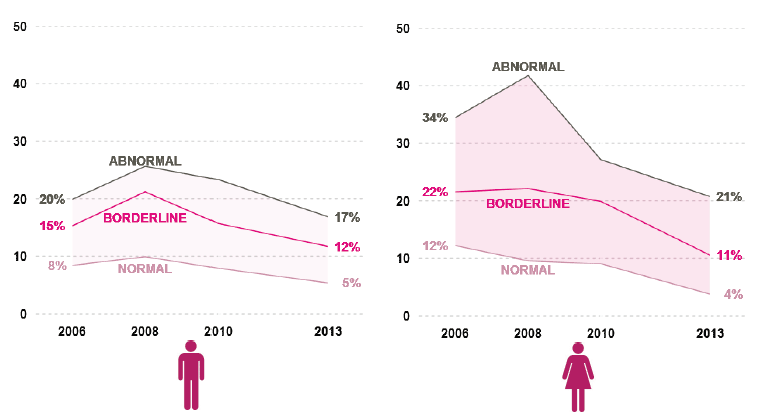
Base: all 15 year olds (full bases in Appendix A, Table A.12)
An additional measure of mental wellbeing - the Warwick-Edinburgh Mental Well-being Scale (WEMWBS)[33] - was added to SALSUS in 2010. Respondents are given 14 positively worded questions and asked to score on a five point scale to best describe their experience over the past 2 weeks. These individual scores are combined and the resulting score (ranging from 14 to 70) is used to determine mental wellbeing. A full discussion of WEMWBS scores are discussed in the report Mental health and wellbeing among adolescents in Scotland: profile and trends. [34] A WEMWBS score of 41-45 could indicate high risk of psychological distress and an increased risk of developing depression and 40 or less suggests the respondent could be at high risk of major depression.[35]
As with the SDQ, girls are more likely than boys to have a lower WEMWBS score. Pupils with below average WEMWBS scores are also more likely to be regular smokers than those with average or above average scores, but of those who are below average, the percentage who smoke is roughly the same for both genders (Figure 4.26). Smokers had a lower average WEMWBS score than non-smokers. This is especially the case for girls - the difference is so marked that non-smoking girls have a lower average score than regularly smoking boys (Figure 4.27).
Figure 4.26 - WEMWBS scores in 2013: percentages in score bandings
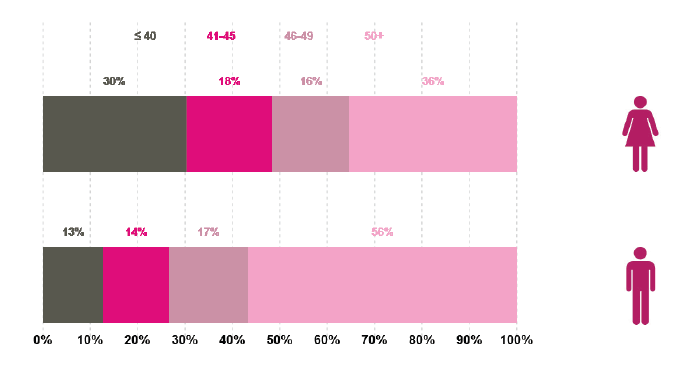
Base: all 15 year olds - boys (7482), girls (7424)
Figure 4.27 - WEMWBS scores in 2013: grouped by gender and smoking category
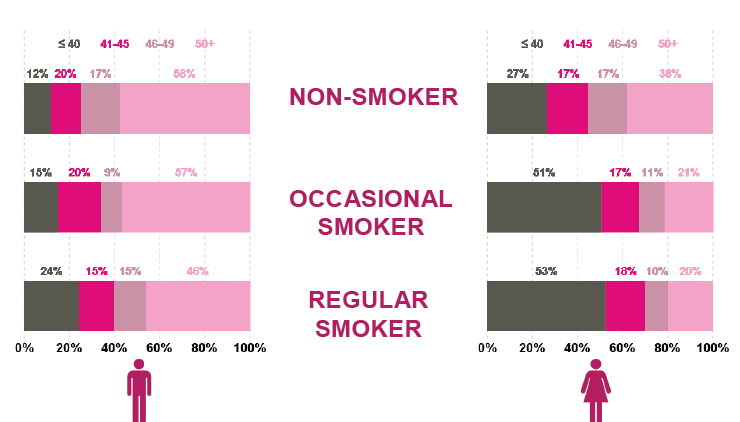
Base: all 15 year olds (boys, girls) - regular (554, 624); occasional (238, 410); non-smoker (6591, 6328)
Contact
Email: Fiona MacDonald
There is a problem
Thanks for your feedback